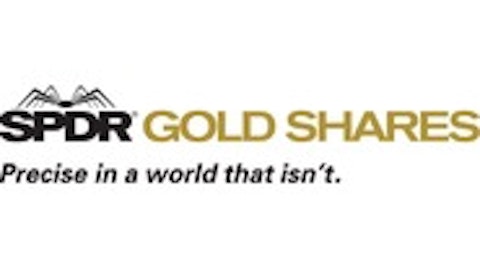I am not in favor of letting daily news affect my long-term investments. Even so, the Cyprus news, with fears on the safety of paper money flaring up, reminded me of the necessity to diversify into commodities. In the following, I will explain my line of thoughts, starting at physical gold and ending up with an investment into shares of the gold miner Goldcorp Inc. (USA) (NYSE:GG).

As a security against inflation and taxation, physical gold is often named as the most obvious choice:
Gold Price in US Dollars data by YCharts
Based on the historical data, one might be more eager to sell gold rather than to buy it. On a side note, I believe that the Cyprus panic will be forgotten in a few weeks — the same happened to Italy’s election which left the third largest economy of the euro-zone effectively unruled. In my opinion, the latter poses a much larger threat to Europe’s political stability than Cyprus, but not enough for me to invest in physical gold at these prices.
Having ruled this out, the next step is to turn towards mining stocks. But how to invest if you are not an expert? Which stock do you buy, if you do not have much insight into the industry?
Invest broadly into the market via an ETF?
It is commonplace that it is hard to beat the market even if you are an expert; so a natural starting point is a miners’ ETF like the Market Vectors Gold Miners ETF (NYSEARCA:GDX).
Since mid 2011 gold euphoria has been fading, stopping the gold rally and sending gold miners to a 40% descend. Is now a good time to start investing broadly into the miners via an ETF?
Besides technical considerations (“falling knives”), it gives me pause that the sentiment towards the sector as a whole still seems negative. I quote Morningstar’s Samuel Lee, quoted itself on barrons.com:
“Despite seemingly attractive fundamentals and technicals, the gold-mining sector has terrible structural features that should give the long-term investor pause. Foremost, the capital expenditures are huge and ongoing. Most of the easily mined sources of gold are tapped out or mature, so to keep production going, miners now have to process lower grades of ore, dig deeper, or venture into unstable regions where infrastructure and rule of law are nonexistent or a shambles. Not only that, but major projects often run afoul of unexpected cost overruns or disappointing yields.”
It looks as if some consolidation is going on behind the scenes, indicating that not all stocks in the ETF are worth the money. I thus decided to postpone the ETF idea to a later time. One could stop here and look elsewhere, but I decided to do some stock-picking.
Stock picking
To keep things simple, I consider only the market leaders. I require a market cap of at least $10 billion. Size stands here for stability and diversification (into various mines and countries). Also, even if I personally do not have the insights needed to assess smaller competitors, I hope that the market leaders do have this knowledge; due to their size and financial power, they should be able to pick the best mines as targets for take-overs.
This leads me to my second criterion, namely financial power. In order to emerge as a winner from the consolidations, I look for small debt levels (say, a debt over equity ratio smaller than 10%). My naive thinking is that this should reduce the pressure to dump projects that could turn out profitable in the long term; moreover, it should enable the company to benefit from the problems of the competitors. This criterion may be questionable (especially since it rules out Barrick Gold Corporation (USA) (NYSE:ABX) and Newmont Mining Corp (NYSE:NEM) which pay nice dividends), but for now I stick to it.
Applying these criteria to the positions in the Market Vectors ETF, the following candidates remain: Goldcorp Inc. (USA) (NYSE:GG), Yamana Gold Inc. (USA) (NYSE:AUY), and Silver Wheaton Corp. (USA) (NYSE:SLW).
Let us look at the last one first, a silver streamer. The balance sheet looks quite attractive, so it may be worth a second thought. However, according to Fool’s contributor Mike Thiessen’s analysis, the company (market cap $11.5 billion) “has just 25 employees,” which sets me aback. As much as I like sleek and efficiently-run administrations, this looks a bit too sleek for a stable and sustainable business, at least at first glance; hence, I decided to return to this stock at a later time.




